Choosing vocalizations
by the LXX translators /
Επιλογές φωνηεντισμού
από τους μεταφραστές της Εβδομήκοντα

The translation of the Septuagint goes back to a Hebrew Vorlage, which, apart from the casual use of scriptio plena, did not mark vowels. On the other hand, the Greek renderings of this Vorlage obviously imply certain vocalizations.
Of course, the translators of the Septuagint had a certain knowledge of the Hebrew language, which certainly gave them an appropriate understanding of the consonantal framework in most cases. On the other hand, the biblical text contains many Hebrew words and passages, which can be vocalized in different ways involving different meanings. Why then did the translators choose the one way and not the other? What was their understanding based on? The aim of the following investigation is to clarify this question.
Η μετάφραση των Εβδομήκοντα ανάγεται σε ένα εβραϊκό πρωτότυπο, το οποίο εκτός από τη συνήθη χρήση της scriptio plena, δεν σημείωνε τα φωνήεντα. Από την άλλη πλευρά, οι ελληνικές αποδόσεις αυτού του πρωτοτύπου είναι προφανές ότι προϋποθέτουν συγκεκριμένους φωνηεντισμούς.
Φυσικά, οι μεταφραστές της Εβδομήκοντα είχαν ως κάποιο βαθμό γνώση της εβραϊκής γλώσσας, που τους έδινε σίγουρα τη δυνατότητα να έχουν ορθή κατανόηση του συμφωνικού πλαισίου στις περισσότερες των περιπτώσεων. Από την άλλη πλευρά, το βιβλικό κείμενο περιέχει πολλές εβραϊκές λέξεις και περικοπές, οι οποίες μπορούν να φωνηεντιστούν με διαφορετικούς τρόπους που συνεπάγονται διαφορετικές σημασίες. Γιατί λοιπόν οι μεταφραστές επέλεξαν τον ένα τρόπο και όχι τον άλλο; Πάνω σε τι βασιζόταν η κατανόησή τους; Ο σκοπός της ακόλουθης εξέτασης είναι να διευκρινίσει αυτό το ζήτημα.
* Stefan Schorch,
“The Septuagint and the Vocalization of the Hebrew Text of the Torah”
[«Η Εβδομήκοντα και ο Φωνηεντισμός του Εβραϊκού Κειμένου της Τορά»]
[English/Αγγλικά, PDF],
in: / στο:
 Melvín K.H. Peters (ed.),
Melvín K.H. Peters (ed.),
XII Congress of the International Organisation for Septuagint and Cognate Studies,
Leiden 2004. Leiden/Boston: Brill, 2006 (Septuagint and Cognate Studies; 54),
pp./σσ. 41, 42 [41-54].
Melvín K.H. Peters (ed.),

No comments:
Post a Comment